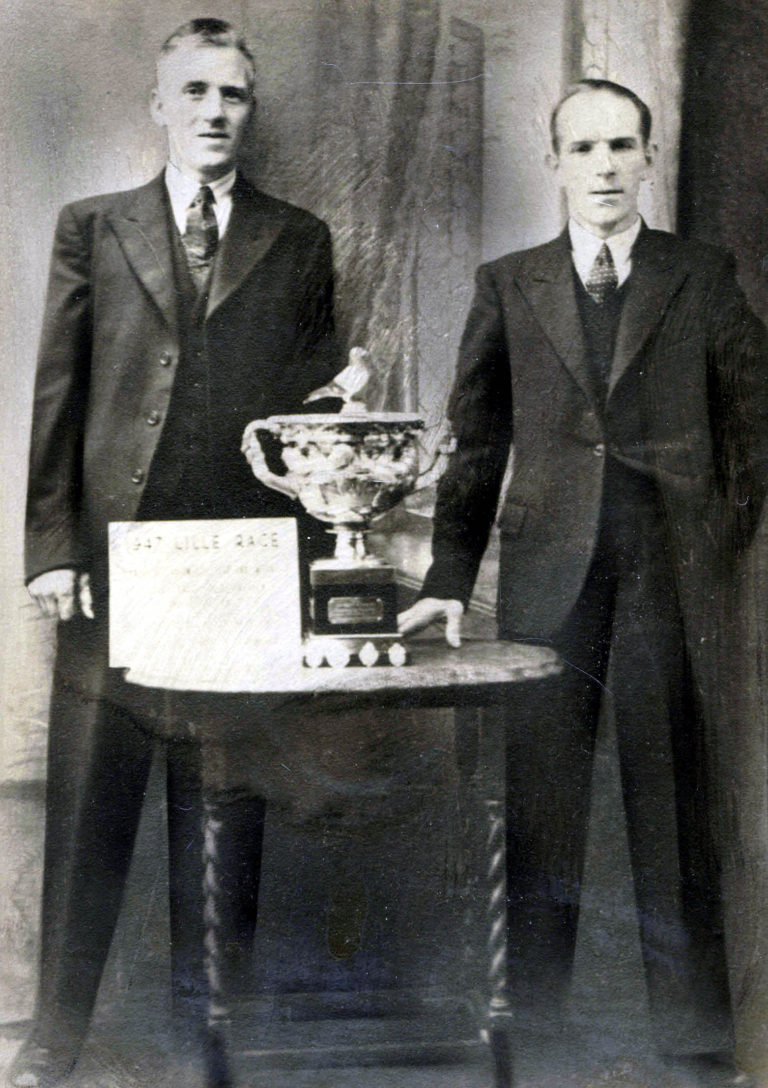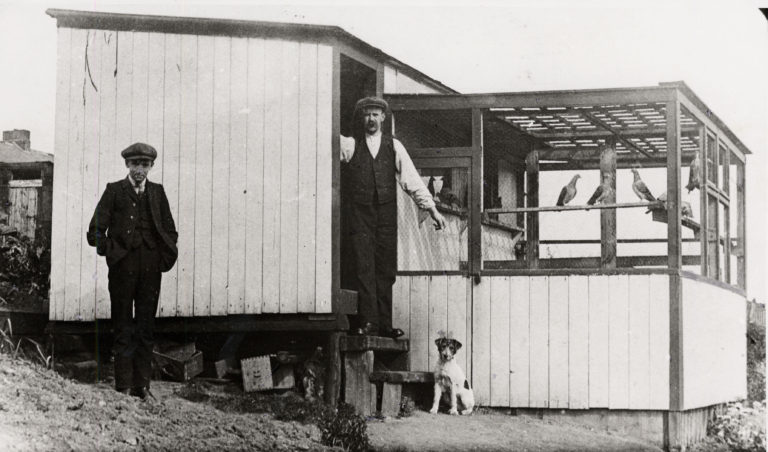Photographs of Pigeon Keeping and Racing, 1904-1947
Reference: NRO 05757/24, NRO 05729/J/7/4
Suggested age groups: KS1, KS2, KS3, KS4, Lifelong Learners
Subject areas: History, Literacy, Art, Maths
CONTEXT
NRO 05757/34 Black and white photograph of two pigeon fanciers from Chevington Drift, Red Row with cup and certificate for Lille Race, 1947
NRO 05729/J/7/4 Black and white photograph of Billy and Tom Oliver at their pigeon cree at Dene Row, Holywell, 1905
During the late-1800s and 1900s keeping, racing, and showing pigeons became popular with industrial workers and especially the miners of northern England.
Men (very few women took part) took their pigeons to shows. The judges at the shows examined the pigeons and awarded prizes, like a dog or cat show. These were sometimes at “Feather and Fur” shows where other birds and animals, such as rabbits would be “shown”.
Northumberland Archives holds a document from Bedlington Poultry Society’s 10th Annual Exhibition in 1874 (SANT/BEQ/5/4/9/2/7 and 8).
Pigeon fanciers use the birds’ ability to find their way back home in races. The birds are transported long distances and set free. A timer is started. When the birds reach their home cree the timer is stopped.
NRO 05757/34 shows a cup won by the men in the photograph whose pigeon flew from Lille in France to Red Row, Northumberland (according to Google Maps, this journey would be 762km by car).
During the First and Second World Wars restrictions were put on pigeon keeping. The British authorities feared that pigeons could be used to carry messages to their enemies.
Pigeon fancier – someone who kept pigeons
Pigeon cree – loft or shed built (or repurposed) to keep pigeons
Homing pigeon – a racing pigeon that would be released and would fly home
ACTIVITIES
ACTIVITY 1
Background
During the late-1800s and 1900s keeping, racing, and showing pigeons became popular with industrial workers and especially the miners of northern England.
SEE
See: What is pigeon racing?
See: What is pigeon showing?
See: Who was involved in pigeon keeping?
See: When was pigeon keeping most popular?
See: What is shown in each of these photographs?
THINK
Think: Why were mostly men involved in pigeon keeping?
Think: What types of hobbies were women from mining communities involved in?
Think: What took place at pigeon shows?
Think: What traits might a winning pigeon have?
DO
Do: Create a map showing the route the pigeons might have taken from Lille to Red Row.
Do: Find out the average speed of a racing pigeon.
Do: Work out how long it might take a pigeon to fly from Lille to Red Row.
Do: Write a poem about your journey from the perspective of a racing pigeon.
Do: Draw a prize winning pigeon.
Do: Create an origami pigeon.
Do: Create a coop to keep your origami pigeons in.
Do: Watch the Sid Chaplin “The Pigeon Cree” animation.
Do: Create a stop-motion animation of a pigeon race.
Resources
OTHER ONLINE RESOURCES
Pigeon Racing
Royal Pigeon Racing Association website, page about the history of pigeon racing: https://www.rpra.org/pigeon-history/
Royal Pigeon Racing Association website, page about pigeons during Second World War: https://www.rpra.org/pigeon-history/pigeons-in-war/
British Pathe website, video of a pigeon race. Shows baskets used for transporting pigeons being unloaded from a train, pigeons being released and arriving home. (1947, 1 min 20 seconds) https://www.britishpathe.com/video/pigeon-race
BBC website, pdf download of PIGEON RACING AND WORKING-CLASS CULTURE IN BRITAIN, c. 1870–1950, Cultural and Social History, Volume 4, Issue 3, 2007 by Martin Johnes, from https://www.bbc.co.uk/radio4/history/making_history/pigeon.pdf
YouTube website, Channel 4 document “The Fancy” (1986, 1 hour). Shows men in industrial communities raising and racing pigeons. https://www.youtube.com/watch?v=Z-xBn4u5C5g
YouTube website, video animation of Sid Chaplin short story “The Pigeon Cree”, narrated by Mike Neville, animated by Sheila Graber (about 9 minutes): https://www.youtube.com/watch?v=wDpvyWJTp70
Tutorial by Sheila Graber on using chalks/pastels for animation: https://www.youtube.com/watch?v=mrrejxYtdLU
Sid Chaplin’s archive can be found at Newcastle University Library Special Collections: https://www.ncl.ac.uk/library/special-collections/browse/collection_details/?id=56
YouTube website, BBC Earth video “How Do Homing Pigeons Get Home?” (2014, 2 minutes 25 seconds) https://www.youtube.com/watch?v=Wl0Ii29XmNk
Defence of the Realm Act, WW1
Spartacus Educational website, page about the Defence of the Realm Act in First World War: https://spartacus-educational.com/FWWdora.htm
Pigeons during WW1
Museum of History of Science, Oxford University, pdf download about pigeons during First World War: https://blogs.mhs.ox.ac.uk/innovatingincombat/files/2013/03/IoC-carrier-pigeons.pdf
The National Archives “Great Wharton” website, page about control of pigeons during First World War: https://www.nationalarchives.gov.uk/first-world-war/home-front-stories/policing-pigeons/#:~:text=Under%20the%20Defence%20of%20the,a%20permit%20from%20the%20police



